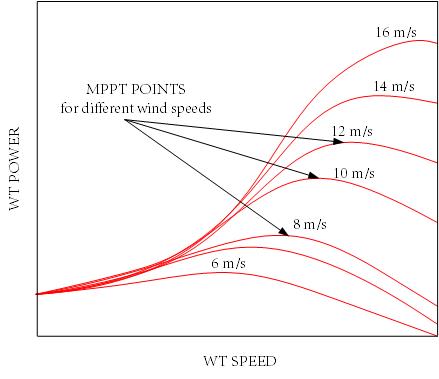No. Grid-Tied solar inverters cannot be used directly with wind turbines. Solar inverters are different from wind turbine inverters. A string of solar panels and a wind turbine have distinct power characteristics, and their inverters are engineered differently. Wind Turbines have large and rapid voltage fluctuations as compared to their counterparts, the solar arrays.
GT Solar inverters apply a control algorithm on the I-V curve of strings of solar panels for tracking the Maximum Power Point. This control algorithm is called MPPT Algorithm, and it maximizes the energy extracted from the strings of solar panels. The string is the dynamic source of power input to the inverter.
On the other hand, wind turbine controllers use a different Power Curve, and integrating a solar inverter directly is impractical. However, a solar inverter can be modified for use with wind turbines. Actually, its control algorithm is changed according to the power characteristics of the wind turbine.
Wind Turbines fitted with Permanent Magnet Generators (PMG) give three-phase AC voltage, the frequency and magnitude of voltage of which constantly change according to the speed of the wind. An inverter cannot be directly connected with this type of power source; rather an AC/DC converter is essentially required as indicated in figure 1. This is usually called a WT Interface Controller or simply WT Controller. It rectifies the ac into dc which then the integral boost converter amplifies to stabilize the voltage of DC link. The stabilized voltage at the input terminals of the inverter increases its efficiency.

Figure 1: Wind Turbine, its controller and the grid-tied inverter
How Wind Turbine Controller extracts maximum power from the wind turbine?
The WT Interface Controller maintains the optimum speed of the wind turbine rotor at different wind speeds. The optimum speed is at which maximum power is extracted from the turbine. The controller extracts the maximum power taking into account the Power-Speed characteristic of the WT generator and the wind speed. The maximum power is different for different wind speeds. It is not possible to obtain maximum power from the WT at all wind speeds due to their nonlinear behavior. Figure 2 shows the relation between the output power of turbine and its rotor speed for different wind speeds. It is seen that the optimum rotor speed is different for various wind speeds to obtain the maximum power of turbine.

Figure 2: Wind Turbine power-speed characteristics at different wind speeds
The variable speed MPPT algorithm, making use of the WT rotor speed sensors and anemometer for wind speed, maintains the optimum speed of the wind generator. The Controller and the Inverter communicate with each other and the controller maintains the optimum speed of the WT by coordinating with the inverter to extract maximum power from the WT. The inverter decouples the WT generator and WT controller from the grid, maintaining 50/60 Hz synchronization with the grid and at the same time allowing the WT generator to operate at variable speed.
The WT Controller may also use the “Divert Load” also called the “Dump Load” for maintaining the optimum turbine speed. WTs operate within speed limits bounded by cut-in and cut-out speeds. Dump Load is a regulatory requirement as it protects the WT from over-speeding in case of grid loss.
Can you connect a wind turbine and solar panel to the same charge controller?
No. The two MPPT charge controllers cannot be used interchangeably. Solar charge controllers are different from the WT charge controllers in several ways. Firstly, the MPPT control algorithms of both types of charge controllers are different. Secondly, a WT charge controller has Divert Load (also called the Dump Load) control capability. This is essential for protecting the wind turbine/generator from dangerous over speeds. The dump load control is not required for PV charge controllers.